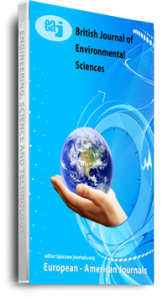Petrochemical effluent could hamper the quality of a water body and contribute to the contamination of nearby aquifers and habitats. This study investigated the concentration of some physicochemical parameters (pH, Temperature, odour, colour, conductivity, alkalinity, TSS, TDS, BOD, iron, lead, phosphate) and TPH in a suspected petroleum hydrocarbon contaminated river in Okirika and the effluents discharged from the Port Harcourt Refinery Company (PHRC). The effluents for the analysis were collected at the point of discharge and the water samples were collected at 100m downstream, 200m downstream and 100m upstream. The samples for trace metal analysis were collected in 1liter amber bottles and fixed with concentrated‘ HNO3 in a ratio of 2:500; samples for other physicochemical parameters were collected in 1liter sterile containers, while those for TPH were collected in a glass container and fixed with concentrated H2SO4 in a ratio of 2:500. However, all samples collected were preserved in ice-packed cooler. The statistical package for the social science SPSS (0) version l7.0 was used to analyze the emerging data. The interaction between the physicochemical parameters was explored using the Pearson Product Moment Correlation (r) and further associations were investigated using linear regression. The one-way ANOVA was used to determine variance equality in spatial means of the physicochemical parameters, which gave a P value of 0.111823, (<0.05), thus giving criterion to the acceptance of the Ho hypothesis. From the result of the analysis, pH ranged between 5.28 and 6.39 (5.90.276), conductivity showed a significant variation; it ranged between 40.00 and 10,400 (2,8402,521.9), there were no variation in the values of temperature across the sampling locations. Total dissolved solids (TDS) varied significantly between 20.00 and 7,280.00 (1,991.31,764.46), total suspended solids (TSS) also varied between 17.00 and 41.00 (25.35.54), TPH varied slightly between 7 and 17 (11.82.136), Sulphate varied significantly with values ranging between 6.20 and 310.00 (107.168.68), lead (pb) varied slightly between 0.001 and 0.052 (0.000.013), phosphate ranged between 3.400 and 6.200 (5.20.628), iron (Fe) varied slightly, ranging from 0.063 and 1.22 (0.50.25), biological oxygen demand (BOD) value ranged between 48.00 and 80.00 (62.36.765), alkalinity varied significantly, ranging from 20.00 and 70.00 (44.5010.50) respectively. TPH correlated positively with BOD at (r = 0.985). The mean concentrations of all the parameters exceeded the DPR standard in the effluent, while those of BOD, PH, TPH and Phosphate exceeded the FEPA standard at 100m downstream. This confirms that Ekerekana River is contaminated, as a result of the inadequately treated effluents discharged from the Port Harcourt Refinery Company (PHRC).
Keywords:

